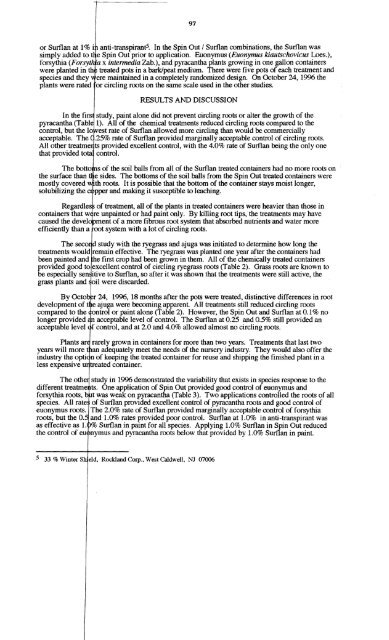Vol. 51â1997 - NorthEastern Weed Science Society
Vol. 51â1997 - NorthEastern Weed Science Society
Vol. 51â1997 - NorthEastern Weed Science Society
You also want an ePaper? Increase the reach of your titles
YUMPU automatically turns print PDFs into web optimized ePapers that Google loves.
97<br />
or Surflan at 1% i anti-transpiranti In the Spin Out / Surflan combinations, the Surflan was<br />
simply added to t e Spin Out prior to application. Euonymus (Euonymus kiautschovicus Loes.),<br />
forsythia (Forsyt . x intermediaZab.), and pyracantha plants growing in one gallon containers<br />
were planted in th treated pots in a bark/peat medium. There were five pots of each treatment and<br />
species and they ere maintained in a completely randomized design. On October 24, 1996 the<br />
plants were rated or circling roots on the same scale used in the other studies.<br />
RESULTS AND DISCUSSION<br />
In the firs study, paint alone did not prevent circling roots or alter the growth of the<br />
pyracantha (Tabl 1). All of the chemical treatments reduced circling roots compared to the<br />
control, but the 10 est rate of Surflan allowed more circling than would be commercially<br />
acceptable. The .25% rate of Surflan provided marginally acceptable control of circling roots.<br />
All other treatme ts provided excellent control, with the 4.0% rate of Surflan being the only one<br />
that provided to control.<br />
The botto<br />
the surface than<br />
mostly covered<br />
solubilizing the<br />
s of the soil balls from all of the Surflan treated containers had no more roots on<br />
e sides. The bottoms of the soil balls from the Spin Out treated containers were<br />
th roots. It is possible that the bottom of the container stays moist longer,<br />
pper and making it susceptible to leaching.<br />
Regardle of treatment, all of the plants in treated containers were heavier than those in<br />
containers that w re unpainted or had paint only. By killing root tips, the treatments may have<br />
caused the devel ment of a more fibrous root system that absorbed nutrients and water more<br />
efficiently than a oot system with a lot of circling roots.<br />
The seco d study with the ryegrass and ajuga was initiated to determine how long the<br />
treatments would remain effective. The ryegrass was planted one year after the containers had<br />
been painted and he first crop had been grown in them. All of the chemically treated containers<br />
provided good to excellent control of circling ryegrass roots (Table 2). Grass roots are known to<br />
be especially se itive to Surflan, so after it was shown that the treatments were still active, the<br />
grass plants and oil were discarded.<br />
By Octo r 24, 1996, 18 months after the pots were treated, distinctive differences in root<br />
development of t e ajuga were becoming apparent. All treatments still reduced circling roots<br />
compared to the ontrol or paint alone (Table 2). However, the Spin Out and Surflan at 0.1% no<br />
longer provided acceptable level of control. The Surflan at 0.25 and 0.5% still provided an<br />
acceptable level f control, and at 2.0 and 4.0% allowed almost no circling roots.<br />
Plants ar rarely grown in containers for more than two years. Treatments that last two<br />
years will more t an adequately meet the needs of the nursery industry. They would also offer the<br />
industry the opti n of keeping the treated container for reuse and shipping the finished plant in a<br />
less expensive u treated container.<br />
The othe study in 1996 demonstrated the variability that exists in species response to the<br />
different treatme ts. One application of Spin Out provided good control of euonymus and<br />
forsythia roots, t was weak on pyracantha (Table 3). Two applications controlled the roots of all<br />
species. All rate of Surflan provided excellent control of pyracantha roots and good control of<br />
euonymus roots. The 2.0% rate of Surflan provided marginally acceptable control of forsythia<br />
roots, but the O. and 1.0% rates provided poor control. Surflan at 1.0% in anti-transpirant was<br />
as effective as 1. % Surflan in paint for all species. Applying 1.0% Surflan in Spin Out reduced<br />
the control of eu nymus and pyracantha roots below that provided by 1.0% Surflan in paint.<br />
5 33 % Winter S eld. Rockland Corp., West Caldwell. NJ 07006
















